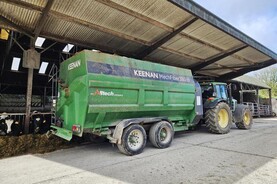At the SIMA trade show in Paris, Keenan showcased the latest in a string of innovations since its acquisition by Alltech in April 2016. The introduction of the Keenan MechFiber 345SP, the first self-propelled machine in the Keenan range, is a result of the collaboration with Italian manufacturer Storti. Speaking at the launch, Keenan CEO Robbie Walker outlined the company’s plans for a long-term relationship with Storti. He emphasised how the benefits of combining technologies was delivering huge innovation for Keenan in a short time frame.
At the SIMA trade show in Paris, Keenan showcased the latest in a string of innovations since its acquisition by Alltech in April 2016. The introduction of the Keenan MechFiber 345SP, the first self-propelled machine in the Keenan range, is a result of the collaboration with Italian manufacturer Storti.
Speaking at the launch, Keenan CEO Robbie Walker outlined the company’s plans for a long-term relationship with Storti. He emphasised how the benefits of combining technologies was delivering huge innovation for Keenan in a short time frame.
Alltech is primarily involved in nutrition, and purchased Keenan with a view to completing feed solution options using the InTouch and Pace system from Keenan. Storti manufactured the first self-propelled feeder in 1967, and introduced the self-loading arm in 1965.
Walker also said that the Storti design, is one that Keenan is happy to deal with as it protects the fibre in the mix. This is what the Keenan Mechfiber mix is based on. The mini-cutter feeding unit, according to Storti, can absorb 95% of the forage on just one revolution. This eliminates the twisting and turning of the grass in the feed unit. The machine is available in 16m³ and 20m³ in the paddle design in Keenan colours. The feeder also has a hydraulically driven conveyor to discharge material either side of the machine.
Storti claims that its design reduces fuel and increases efficiency by 25%. The mechanical drive to the feeder is engaged using a dry clutch system that reduces the overall power requirement. The company believes that a saving of €5,000 per year is made by the farmer by using this machine over other competitors in the same class. On the road, the machine can travel up to 40km/h with an eco drive. The hydrostatic transmission has two ranges – 15km/h to 25km/h and 25km/h to 40km/h – powered by an Iveco 166hp engine that is Tier 4b compliant. The machine is priced at €145,000 for the entry machine rising to €155,000 for the bigger 20m³ machines. So who will buy it? Keenan says there is customer demand from farms with labour problems and also size and time issues. Typically, farms that feed cows twice daily with herds that spend a lot of time indoors will get the most benefit from a machine like this. It can eliminate the need for a tractor and a telehandler or free them up for other work on the farm.





SHARING OPTIONS: